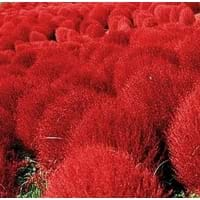Life Span
Biennial and Perennial
Annual
Type
Vegetable
Ornamental Plants, Shrubs
Origin
Europe, Western Asia
Eastern Europe, Western Asia
Types
Not Available
Kochia Indica, Neokochia californica
Number of Varieties
Not Available
Habitat
waste ground, wastelands
gardens, Temperate Regions
USDA Hardiness Zone
4-9
3-11
Sunset Zone
A1, A2, A3, H1, H2, 1a, 1b, 2a, 2b, 3a, 3b, 4, 5, 6, 7, 8, 9, 10, 11, 12, 13, 14, 15, 16, 17, 18, 19, 20, 21, 22, 23, 24
A1, A2, A3, H1, H2, 1a, 1b, 2a, 2b, 3a, 3b, 4, 5, 6, 7, 8, 9, 10, 11, 12, 13, 14, 15, 16, 17, 18, 19, 20, 21, 22, 23, 24
Habit
Rosette/Stemless
Upright/Erect
Flower Color
Yellow
Not Available
Flower Color Modifier
Bicolor
Bicolor
Fruit Color
Brown, Black
Not Available
Leaf Color in Spring
Green
Light Green
Leaf Color in Summer
Green
Not Available
Leaf Color in Fall
Green
Gray Green, Burgundy, Crimson
Leaf Color in Winter
Not Available
Light Green
Leaf Shape
Pinnate
Linear
Sunlight
Full Sun
Full Sun
Type of Soil
Loam
Clay, Loam, Sand
The pH of Soil
Neutral
Acidic, Neutral, Alkaline
Soil Drainage
Well drained
Average
Tolerances
Drought
Drought
Where to Plant?
Ground, Pot
Ground
How to Plant?
Seedlings
Stem Cutting, Transplanting
Plant Maintenance
Medium
Medium
Watering Requirements
Average Water Needs, Do Not over Water, Keep the ground moist but not water-logged
occasional watering once established, Requires consistently moist soil
In Summer
Lots of watering
Moderate
In Spring
Moderate
Moderate
In Winter
Average Water
Less Watering
Soil Type
Loam
Well drained
Soil Drainage Capacity
Well drained
Loamy, Well drained
Sun Exposure
Full Sun
Bright direct sunlight
Pruning
Remove damaged leaves, Remove dead branches, Remove dead leaves
Pinch or prune as they grow to promote branching and bushiness, Remove dead branches
Fertilizers
All-Purpose Liquid Fertilizer
All-Purpose Liquid Fertilizer
Pests and Diseases
Aphids, Armyworm, Cutworms, Downy mildew, Pitch canker, Red blotch
Aphids, Mosquito
Plant Tolerance
Drought
Heat Tolerance, Humidity
Flower Petal Number
Not Available
Not Available
Fragrant Bark/Stem
Yes
No
Foliage Texture
Fine
Fine
Foliage Sheen
Matte
Matte
Attracts
Butterflies
Butterflies, Leaf Hoppers
Allergy
Stomach burn
Eye irritation, Respiratory problems
Aesthetic Uses
Not Available
Beautification, Landscape Designing
Beauty Benefits
Blood purifying, Good for skin
For treating wrinkles, Making cosmetics, Removes dandruff, Skin cleanser
Edible Uses
Yes
Sometimes
Environmental Uses
Air purification
Provides ground cover
Medicinal Uses
Aphrodisiac
Diabetes, Hypotensive, Obesity
Part of Plant Used
Root
Leaves
Other Uses
Food for animals, Used as a nutritious food item
Cattle Fodder, Sauces, Traditional medicine, Used for fragrance, Wood log is used in making fences
Used As Indoor Plant
Yes
No
Used As Outdoor Plant
Yes
Yes
Garden Design
Edible, Herb, Vegetable
Groundcover
Botanical Name
PASTINACA sativa
BASSIA scoparia
Common Name
Parsnip
Burningbush, Kochia
In Hindi
चुकंदर
Bassia scoparia
In German
Pastinake
Besen-Radmelde
In French
Panais
Bassia scoparia
In Spanish
Chirivía
Kochia scoparia
In Greek
Είδος δαυκίου
Bassia scoparia
In Portuguese
cherivia
Bassia scoparia
In Polish
Pasternak
Mietelnik żakula
In Latin
parsnip
Bassia scoparia
Phylum
Magnoliophyta
Angiosperms
Class
Magnoliopsida
Magnoliopsida
Order
Apiales
Caryophyllales
Family
Apiaceae
Chenopodiaceae
Clade
Angiosperms, Asterids, Eudicots
Angiosperms, Eudicots
Tribe
Not Available
Not Available
Subfamily
Not Available
Camphorosmoideae
Number of Species
Not Available
Not Available
Importance of Parsnip and Kochia
Want to have the most appropriate plant for your garden? You might want to know the importance of Parsnip and Kochia. Basically, these two plants vary in many aspects. Compare Parsnip and Kochia as they differ in many characteristics such as their life, care, benefits, facts, etc. Every gardener must at least have the slightest clue about the plants he wants to plant in his garden. Compare their benefits, which differ in many ways like facts and uses. The medicinal use of Parsnip is Aphrodisiac whereas of Kochia is Diabetes, Hypotensive and Obesity. Parsnip has beauty benefits as follows: Blood purifying and Good for skin while Kochia has beauty benefits as follows: Blood purifying and Good for skin.
Compare Facts of Parsnip vs Kochia
How to choose the best garden plant for your garden depending upon its facts? Here garden plant comparison will help you to solve this query. Compare the facts of Parsnip vs Kochia and know which one to choose. As garden plants have benefits and other uses, allergy is also a major drawback of plants for some people. Allergic reactions of Parsnip are Stomach burn whereas of Kochia have Eye irritation and Respiratory problems respectively. Having a fruit bearing plant in your garden can be a plus point of your garden. Parsnip has no showy fruits and Kochia has no showy fruits. Also Parsnip is not flowering and Kochia is not flowering . You can compare Parsnip and Kochia facts and facts of other plants too.





